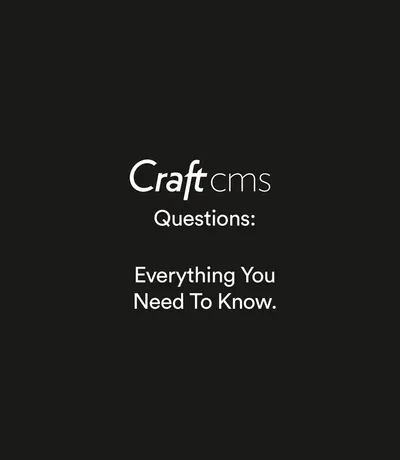Craft CMS Questions: What You Need To Know.


Craft CMS is our preferred choice of CMS for website projects, and we've been using it since 2013. Here's a complete guide on questions and answers surrounding Craft CMS
Craft CMS has both free and paid versions. Craft CMS offers a free version called Craft CMS Solo, which is suitable for small personal websites. However, for larger projects and commercial use, a paid license is required. Full details on Craft CMS pricing are available on their website.
Craft CMS and WordPress are both content management systems, but they have some fundamental differences. Craft CMS is known for its flexibility and scalability, allowing developers to build highly customized websites with ease. It offers a more focused and streamlined interface, tailored for content editors and developers. Craft CMS also has a more robust architecture, providing greater control over content modeling and templating. On the other hand, WordPress is more beginner-friendly, with a vast number of plugins and themes available for easy website setup.
Craft CMS takes security seriously and is considered to be a secure CMS. It follows best practices for web security, such as regularly releasing updates to address vulnerabilities, providing strong user authentication mechanisms, and implementing secure coding practices. Craft CMS also has an active security team that promptly responds to reported vulnerabilities.
Craft CMS provides a straightforward update process. You can update Craft CMS using the built-in updater in the control panel, or via Craft’s very own Command Line Interface. Before updating, it's important to make sure your plugins and custom code are compatible with the new version to avoid any potential conflicts or issues. At Shape, we take care of updating your website for you. This is all done offline in case of any breaking changes.
Craft CMS follows a licensing model based on the edition and the number of user seats required. Craft CMS Solo is free and limited to one user seat. For larger projects, Craft CMS offers a Pro edition with additional features and pricing based on the number of user seats required. Each user seat allows one simultaneous control panel login at a time.
Yes, Craft CMS has an active and supportive community. Craft CMS has an official community forum where users can ask questions, share knowledge, and get help from other Craft CMS users and the development team. Additionally, there are numerous online resources, tutorials, and third-party plugins available to enhance your Craft CMS experience.
Craft CMS has specific hosting requirements. It requires a server running PHP 7.4 or later, with recommended versions of either Apache or Nginx. It also requires a MySQL database, preferably version 5.7 or later, or MariaDB version 10.2 or later. Craft CMS recommends using servers with at least 1GB of memory, but the exact requirements can vary depending on the size and complexity of your website.
Craft CMS does not have a built-in theme system like WordPress. However, Craft CMS has a vibrant marketplace called the Craft Plugin Store, where you can find various pre-made themes, templates, and plugins created by third-party developers. These themes can serve as a starting point for your website, and you can customize them to fit your specific needs.
Yes, Craft CMS can be used as a headless CMS. With Craft CMS's Element API or GraphQL plugins, you can expose your content via APIs and build decoupled front-end applications using your preferred programming languages or frameworks. This allows for greater flexibility in delivering content across multiple platforms and devices.
Craft CMS provides a built-in backup feature that allows you to create manual backups of your site's database and assets through the control panel. Additionally, you can automate backups using plugins or scripts that handle regular database and file backups.
Yes, you can use Craft CMS for e-commerce websites. Craft CMS offers a plugin called Craft Commerce, which provides robust e-commerce functionality. Craft Commerce allows you to create and manage products, set up payment gateways, handle orders and inventory, and customize the shopping experience according to your specific requirements.
Yes, Craft CMS offers multi-language support. You can create and manage content in multiple languages within the CMS. Craft CMS allows you to define different locales, translate content, and manage localized versions of your website. This feature enables you to create multilingual websites and deliver content in multiple languages to your audience.
Craft CMS has specific system requirements. It requires a server running PHP 7.4 or later, with recommended versions of either Apache or Nginx. It also requires a MySQL database, preferably version 5.7 or later, or MariaDB version 10.2 or later. Craft CMS recommends using servers with at least 1GB of memory, but the exact requirements can vary depending on the size and complexity of your website.
Yes, Craft CMS offers a robust API. Craft CMS provides a RESTful API as a core feature, allowing you to interact with your website's content programmatically. You can use the API to retrieve, create, update, and delete entries, categories, assets, and other content elements. Additionally, Craft CMS has plugins available, such as the GraphQL and Element API plugins, which provide additional API capabilities.
Yes, Craft CMS can be used for membership sites. Craft CMS offers user management features that allow you to create and manage user accounts, assign different user roles and permissions, and implement member-only areas on your website. By utilizing Craft CMS's flexibility, you can build and customize membership functionality according to your specific requirements.
Craft CMS has a relatively gentle learning curve compared to some other content management systems. Its intuitive user interface, clear documentation, and active community make it easier for users to get started and understand the system. However, as with any CMS, the learning curve can vary depending on your previous experience and the complexity of your project.
Craft CMS plugins are extensions that add additional functionality to the CMS. Craft CMS has a vibrant plugin ecosystem with a wide range of plugins available. These plugins can help enhance your website's capabilities by providing features such as SEO optimization, form builders, image manipulation, integrations with third-party services, and much more. Craft CMS plugins can be developed by the Craft CMS team or by third-party developers.
Yes, Craft CMS has built-in support for GraphQL. The GraphQL API is available through the Craft CMS Pro edition, which allows you to query and retrieve data using the GraphQL query language. GraphQL provides a flexible and efficient way to request specific data from your Craft CMS backend, enabling you to build powerful and optimized front-end applications.
Yes, you can use version control with Craft CMS. Craft CMS supports version control systems like Git, allowing you to track changes to your code, templates, and configuration files. By using version control, you can manage and collaborate on your Craft CMS project more effectively, track changes over time, and revert to previous versions if needed.

Web Developer, Tom, working in the MadeByShape studio
Yes, Craft CMS can be used in serverless architectures. Craft CMS can be deployed on various hosting platforms, including serverless platforms like AWS Lambda or Google Cloud Functions. By utilizing serverless architecture, you can scale your Craft CMS website dynamically, reduce infrastructure costs, and achieve high availability and scalability.
Yes, Craft CMS offers content versioning. Craft CMS keeps a revision history of your content, allowing you to track and manage changes made to entries, categories, and other content elements. This feature enables you to review and revert to previous versions of content if needed, providing an added layer of control and oversight over your website's content.
Craft CMS is developed by Pixel & Tonic, a software company based in the United States. Pixel & Tonic was founded by Brandon Kelly, who is the original creator and lead developer of Craft CMS. He started working on Craft CMS in 2011 and has been actively involved in its ongoing development and improvement. The company has a dedicated team of developers and designers who continue to advance and improve Craft CMS.
Craft CMS is a content management system (CMS) that provides a flexible and customizable platform for building and managing websites. We love it for its user-friendly interface and powerful features that cater to both developers and content editors.
Craft CMS allows users to create and organize content in a structured manner using sections, entries, and fields. It provides a solid templating engine that enables developers to build highly customized websites. Craft CMS also comes out of the box with features such as assets, users, localization, and version controlling. It is constantly evolving and improving, and we love it.
Yes, Craft CMS can be used for large-scale websites. Craft CMS is a flexible and powerful content management system that can handle complex and robust websites with a large amount of content and high traffic.
Craft CMS offers a scalable architecture that allows you to build and manage large-scale websites efficiently. It provides features such as hierarchical structures, custom fields, and multiple content types, which are beneficial for organizing and managing content at scale.
Yes you can import content from other CMS platforms into Craft CMS. Pixel & Tonic - the developers of Craft CMS, have built a Craft CMS plugin for this very thing.
Feed Me is a plugin for Craft CMS that simplifies the process of importing content, whether it's a one-time import or done on a regular basis. This plugin supports various feed formats such as XML, RSS, ATOM, CSV, or JSON, enabling you to effortlessly import your content as Entries, Categories, Craft Commerce Products (including variants), and other elements.
To name a few, Craft CMS offers:
Flexible and customizable content modeling
Powerful Twig templating engine
Live preview for real-time content editing
User-friendly control panel interface
Extensibility through a robust plugin ecosystem
Built-in multi-site support for managing multiple websites
Workflow management and content versioning
Advanced user permissions and access control
SEO-friendly features like customizable URLs and metadata
Mobile-responsive and accessibility-focused design
Robust caching and performance optimization tools
Built-in localization and internationalization support
Secure and reliable with regular updates and security patches.
No, Craft CMS does not have a built-in visual page builder like some other content management systems. Craft CMS takes a more developer-focused approach, prioritizing flexibility and customization.
Craft CMS emphasizes the separation of content and presentation, allowing developers to create and design templates using HTML, CSS, and the Twig templating language. This approach provides greater control and flexibility for developers to build custom layouts and designs.
Here at MadeByShape we are currently accepting new projects, so feel free to send over your project details via our project planner. Check out our Craft CMS resource website The Ovoby for more on Craft CMS.
I've been at Shape for around 8 years now. I bagged a couple of weeks of work experience at the end of my first year at Salford Uni and from then on, well what can I say, they couldn't get enough of me.